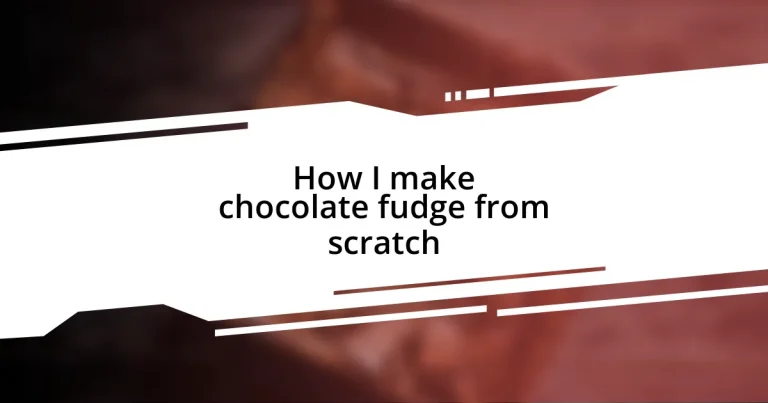Key takeaways:
- Use high-quality chocolate, sweetened condensed milk, and a mix of sugars for optimal flavor and texture in fudge.
- Essential tools include a heavy-bottomed saucepan, candy thermometer, and sturdy spatula for successful fudge-making.
- Monitor the temperature carefully during cooking, aiming for the soft ball stage (234°F to 240°F) to achieve the desired consistency.
- Store fudge in an airtight container or freeze it individually wrapped to maintain its freshness and texture over time.
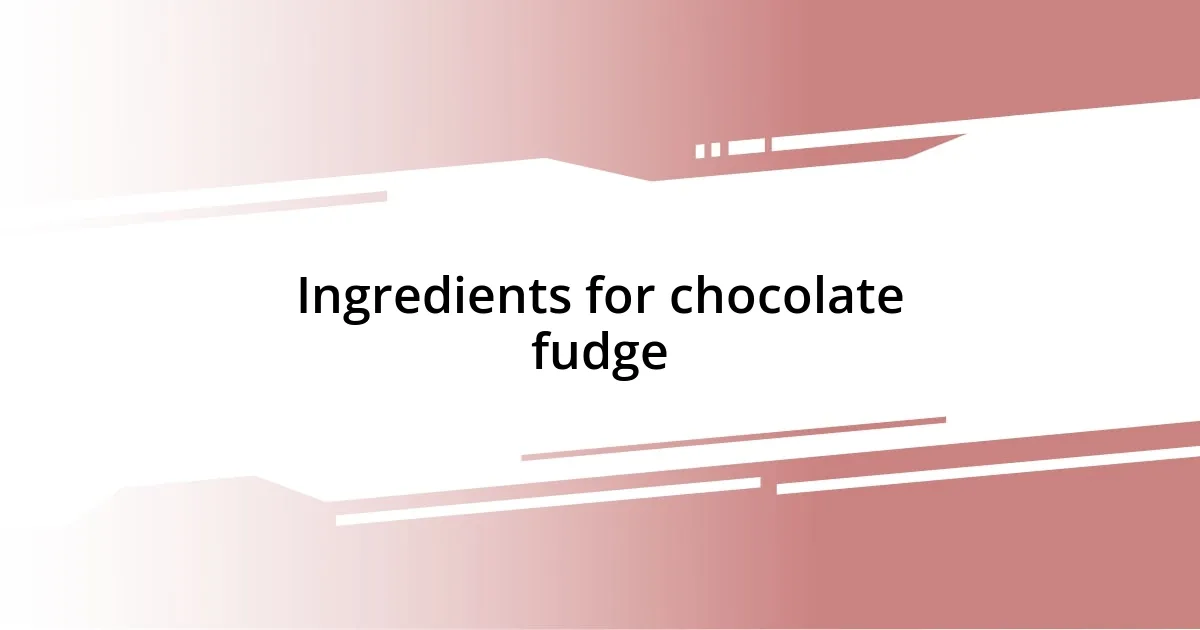
Ingredients for chocolate fudge
When I think about making chocolate fudge, the first ingredient that comes to mind is, of course, the chocolate. I prefer using high-quality semi-sweet or bittersweet chocolate bars, as they melt beautifully and create a rich flavor. Have you ever bitten into a piece of fudge and felt that instant burst of chocolatey goodness? That’s what the right chocolate can do.
Next up are the sweeteners. Granulated sugar is pretty standard, but I often like to experiment with brown sugar for a deeper caramel note in the flavor profile. Aren’t you curious about the way different sugars can completely change the texture? I remember once substituting in some maple syrup, and the taste was surprisingly delightful—a little twist that felt like a warm hug from a cozy café.
Lastly, we can’t forget about the creamy elements. Sweetened condensed milk is a must-have for that luscious, smooth consistency. It’s like liquid gold in fudge-making! The first time I opened a can and stirred it in, I couldn’t help but be amazed at how it transformed the mixture. If you haven’t tried it yet, what are you waiting for? Trust me, it makes all the difference in achieving that melt-in-your-mouth experience that’s so hard to resist.
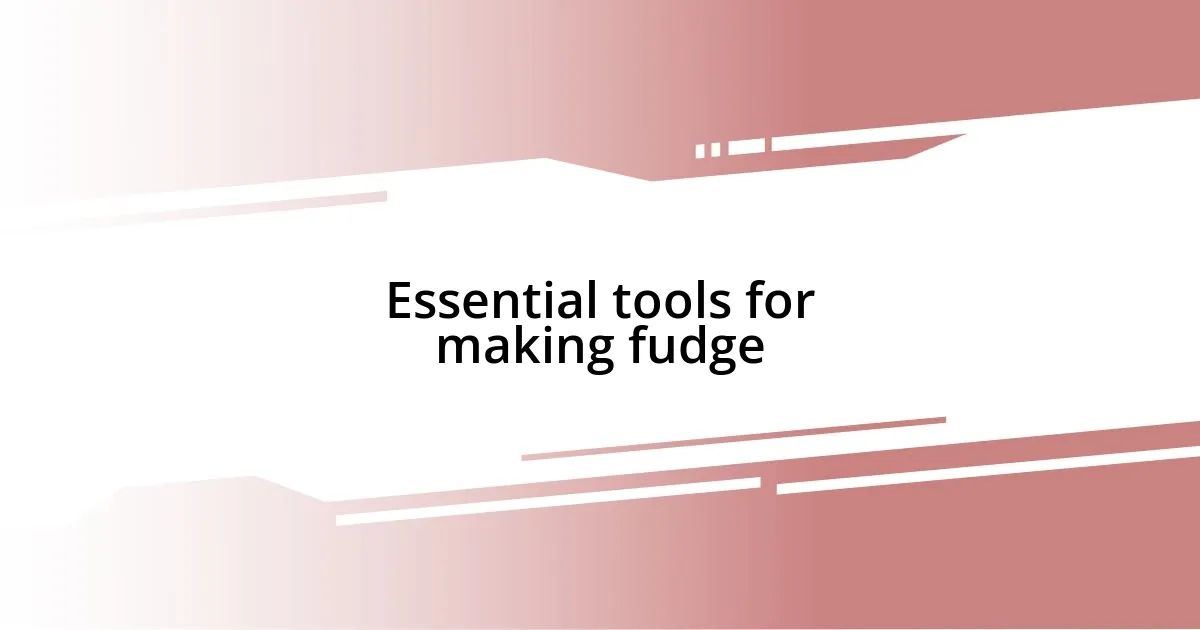
Essential tools for making fudge
When making fudge, it’s essential to have the right tools at your disposal. A heavy-bottomed saucepan is crucial for even heat distribution, preventing those dreaded burnt spots that can ruin your fudge. I remember the time my cheap pan led to a lumpy mess that was hardly salvageable. Trust me, investing in a good saucepan makes all the difference!
Another vital tool in your fudge-making arsenal is a reliable candy thermometer. This little gadget helps you monitor the temperature, ensuring your fudge reaches that sweet spot—soft ball stage—perfect for achieving the ideal consistency. The first time I used one, I was amazed at how much more control I had over the process. It took the guesswork out and allowed me to focus on achieving that perfectly smooth texture.
Finally, don’t overlook the importance of a sturdy spatula or wooden spoon. These tools are perfect for stirring and folding ingredients together, plus they help prevent any unintentional splashes. I can still recall the excitement of pulling my fudge from the pan with my trusty spatula, feeling like a real chocolate artist. Having quality tools makes not just the process easier but also the end product even more enjoyable.
| Tool | Purpose |
|---|---|
| Heavy-bottomed saucepan | Prevents burning; distributes heat evenly |
| Candy thermometer | Monitors the temperature for perfect consistency |
| Sturdy spatula or wooden spoon | Stirs and folds ingredients to prevent splashes |

Preparing the chocolate mixture
Preparing the chocolate mixture is truly the heart of fudge-making. I take my chosen chocolate—usually dark or semi-sweet—and chop it into small, even pieces. I find that this step not only helps it melt uniformly but also adds a certain level of satisfaction in the process, almost like slicing into a beautifully ripe fruit. As the chocolate starts to melt in the saucepan, I can instantly sense that rich aroma filling the kitchen. It’s a sensory experience that reminds me of cozy family gatherings during the holidays.
Once the chocolate has melted smoothly, I gradually mix in the sweetened condensed milk and sugar. This is where the magic happens! Stirring it all together, I watch as the mixture transforms into a velvety blob of potential deliciousness. It’s important to constantly stir to avoid any scorching, which I learned the hard way during my first attempt when I got distracted by a pop song on the radio! Here are the key steps to keep in mind:
- Chop the chocolate into small, even pieces for uniform melting.
- Melt the chocolate in a heavy-bottomed saucepan over low heat to prevent scorching.
- Gradually add sweetened condensed milk, stirring continuously for a smooth mixture.
- Be patient and keep the heat low; rushing can lead to burnt spots.
- Mix until completely smooth and glossy, ensuring all ingredients are blended perfectly.
There’s something almost meditative about this process for me. Each stir feels like I’m coaxing out the flavors, guiding them into a perfect balance. When I finally see that glossy sheen, I can’t help but feel a sense of accomplishment. It’s moments like these that remind me why I love making fudge from scratch.
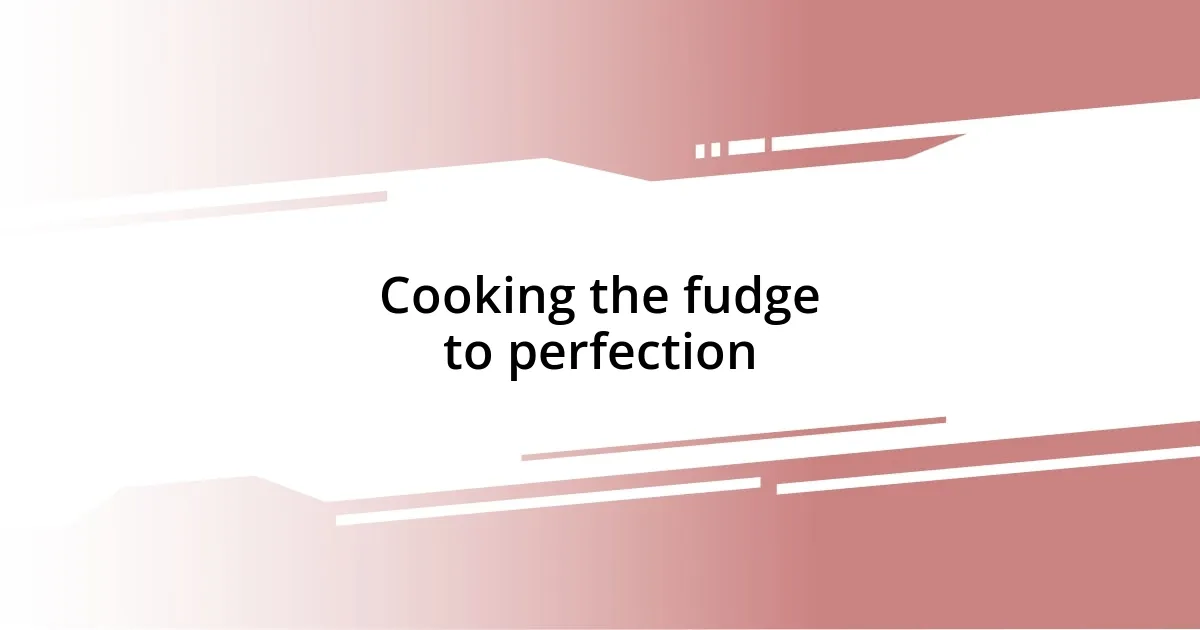
Cooking the fudge to perfection
Cooking fudge to perfection is all about watching the temperature and knowing when to stop. I recall the first time I let my fudge cook a bit too long, thinking I could multitask and check my email. Mistake! It turned into a chewy disaster. I learned that soft ball stage, which is around 234°F to 240°F (112°C to 116°C), is the sweet spot for that melt-in-your-mouth texture. Keeping an eye on that thermometer is essential to achieving fudge success.
Timing plays a crucial role too. The moment the fudge reaches that magic temperature, it’s time to remove it from the heat and let it cool slightly before pouring it into your pan. When I allowed my fudge to cool for just a few minutes, I could pour it without it becoming stoic and harden awkwardly. It may seem trivial, but every step, including this waiting time, contributes to that smooth, rich end result we all crave.
Finally, don’t forget about the final stir before pouring. I always take a moment to inhale the heavenly scent and give the mixture one last swirl. This is where I might fold in some nuts or a pinch of salt, which elevates the flavor and adds a lovely crunch. Have you ever tasted fudge that was just perfect? I believe those final touches can turn a good fudge into something truly extraordinary, and that’s what keeps me turning out batch after batch.

Testing the fudge consistency
Testing the fudge consistency can be a delightful experience, as it brings an opportunity for hands-on learning. I remember the first time I plopped a spoonful of fudge onto a plate to check its firmness, only to realize that it was too runny. It’s a journey of trial and error, but each attempt has sharpened my instincts for what the final texture should feel like. Using the cold water test—dropping a bit of the mixture into a glass of cold water—I can see if it forms a soft, pliable ball. It’s almost like a little science experiment in my kitchen!
Another method I rely on is the “scoop and cool” technique. I scoop a small amount of fudge onto a prepared surface, letting it cool for a moment. When it’s just the right consistency, it should hold its shape without becoming too stiff. I once tasted oozy fudge that melted in my mouth, which made me realize that this step is vital for achieving that creamy goodness we all crave. It’s funny how a simple test can lead to such diverse outcomes!

Cooling and cutting the fudge
Once the fudge cools in the pan, I often find myself at the most exciting part—cutting it! I recommend letting it set at room temperature for about an hour; this gives it that perfect chewy texture without becoming overly hard. When I take it out of the pan, it’s like unveiling a little surprise. Have you ever felt the anticipation of slicing into something homemade? It’s such a rewarding moment.
Cutting the fudge is more than just a practical step; it’s a chance for creativity. I typically use a sharp knife warmed in hot water, which allows for smooth, clean cuts. It’s amazing how a little trick like this makes the process feel elegant. The first few slices reveal that glossy, rich interior, and that’s when my mouth starts watering. Do you ever find yourself snacking on the edges before getting to the neatly cut pieces? I know I do!
As I place the neatly cut squares on a plate, I feel a sense of achievement wash over me. Each piece seems to tell a story of its own, and I can almost imagine how they’ll delight friends and family. I always take a moment to appreciate how something so simple can be so fulfilling. The way they glisten in the light is just the cherry on top, isn’t it? It’s these little moments that remind me why I love making fudge from scratch.
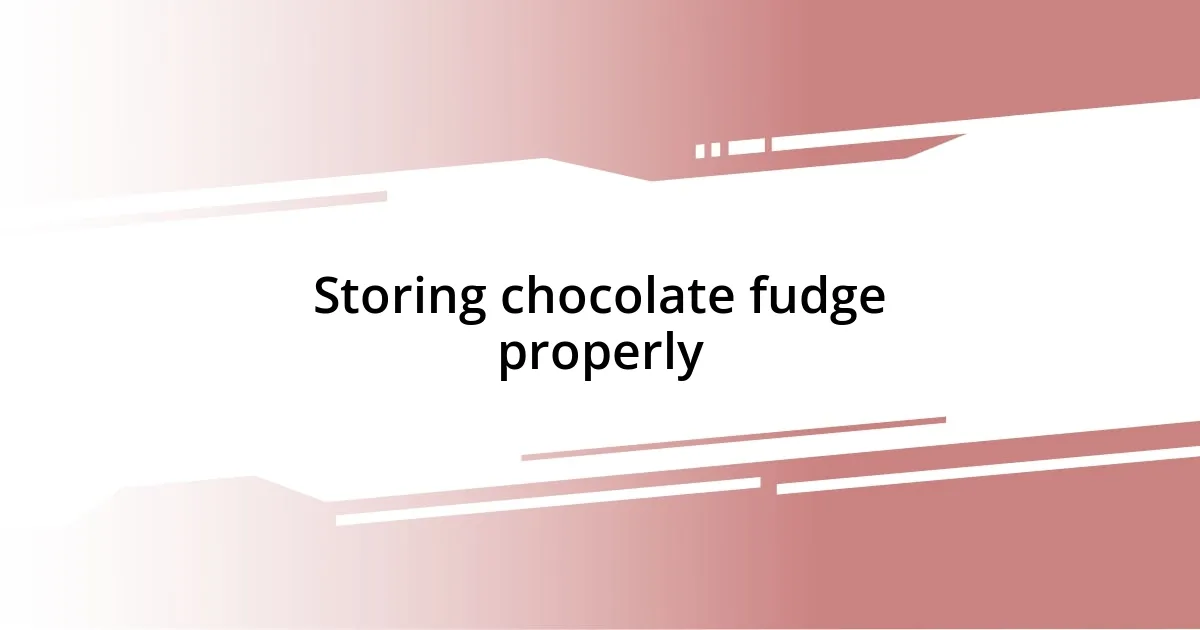
Storing chocolate fudge properly
Storing chocolate fudge properly can be just as crucial as crafting it. I always make sure to let my fudge cool completely before moving it into an airtight container. It’s like giving it a cozy home that protects it from air and moisture. Have you ever opened a container only to find your fudge has hardened or, worse yet, absorbed unwanted flavors from the fridge? That’s a lesson I learned the hard way, and I quickly adapted my storage techniques to avoid it.
When it comes to longer-term storage, I like to wrap my fudge in parchment paper and then place it in the container. This not only helps preserve its soft texture but also keeps it from sticking together. I remember the first time I tried this method—I was amazed at how fresh the fudge tasted even weeks later! I often indulge in a piece from the back of the fridge, and it feels incredible to know it still has that melt-in-your-mouth quality. Wouldn’t you agree that there’s something satisfying about savoring fudge that tastes just as good as when it was freshly made?
If I know I won’t be consuming the fudge quickly, I even consider freezing it. I’ve had great success with this! Just cut it into squares, wrap each piece individually, and pop them into a freezer-safe bag. The first time I defrosted some fudge, my heart raced with excitement, hoping the texture would be intact. To my delight, it was! It reminded me that with the right storage techniques, I can always have a sweet treat ready for those spontaneous cravings or surprise guests. Isn’t it wonderful to share delicious fudge, knowing it still tastes homemade no matter how much time has passed?












